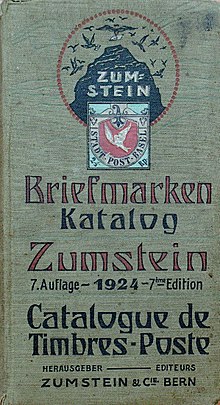
Philately is the study of postage stamps and postal history. It also refers to the collection and appreciation of stamps and other philatelic products. While closely associated with stamp collecting and the study of postage, it is possible to be a philatelist without owning any stamps. For instance, the stamps being studied may be very rare or reside only in museums.

Philatelic literature is written material relating to philately, primarily information about postage stamps and postal history.
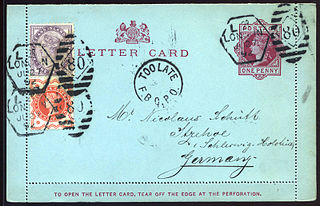
A piece of postal stationery is a stationery item, such as a stamped envelope, letter sheet, postal card, lettercard, aerogram or wrapper, with an imprinted stamp or inscription indicating that a specific rate of postage or related service has been prepaid. It does not, however, include any postcard without a pre-printed stamp, and it is different from freepost for preprinted cards issued by businesses. In general, postal stationery is handled similarly to postage stamps; sold from post offices either at the face value of the printed postage or, more likely, with a surcharge to cover the additional cost of the stationery. It can take the form of an official mail issue produced only for the use of government departments.
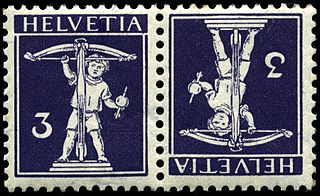
This is a survey of the postage stamps and postal history of Switzerland.

In philately, a cinderella stamp is a label that resembles a postage stamp, but which is not issued for postal purposes by a government administration. There is a wide variety of cinderella stamps, such as those printed for promotional use by businesses, churches, political or non-profit groups. The term excludes imprinted stamps on postal stationery.

A stamp catalog is a catalog of postage stamp types with descriptions and prices.
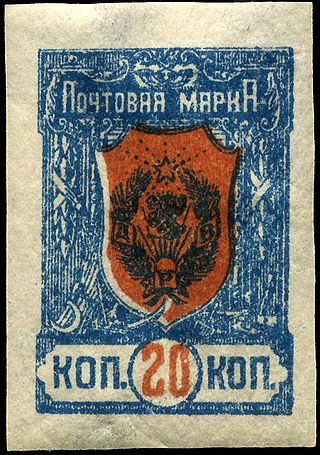
The Far Eastern Republic, sometimes called the Chita Republic, existed from April 1920 to November 1922 in the easternmost part of Siberia. It was formed from the Amur, Transbaikal, Kamchatka, Sakhalin, and Primorye regions. In theory, it extended from Lake Baikal to Vladivostok but, in May 1921, the Priamur and Maritime Provinces seceded. Although nominally independent, it was largely controlled by the RSFSR and its main purpose was to be a democratic buffer state between the RSFSR and the territories occupied by Japan during the Russian Civil War to avoid war with Japan. Initially, its capital was Verkhneudinsk, but from October 1920 it was Chita. On 15 November 1922, after the war ended and the Japanese withdrew from Vladivostok, the Far Eastern Republic was annexed by Soviet Russia.

The Michel catalog (MICHEL-Briefmarken-Katalog) is the largest and best-known stamp catalog in the German-speaking world. First published in 1910, it has become an important reference work for philately, with information not available in the English-language Scott catalog.

The postage stamps of Ireland are issued by the postal operator of the independent Irish state. Ireland was part of the United Kingdom of Great Britain and Ireland when the world's first postage stamps were issued in 1840. These stamps, and all subsequent British issues, were used in Ireland until the new Irish Government assumed power in 1922. Beginning on 17 February 1922, existing British stamps were overprinted with Irish text to provide some definitives until separate Irish issues became available. Following the overprints, a regular series of definitive stamps was produced by the new Department of Posts and Telegraphs, using domestic designs. These definitives were issued on 6 December 1922; the first was a 2d stamp, depicting a map of Ireland. Since then new images, and additional values as needed, have produced nine definitive series of different designs.

In general, philatelic fakes and forgeries are labels that look like postage stamps but have been produced to deceive or defraud. Learning to identify these can be a challenging branch of philately.

This is a survey of the postage stamps and postal history of Germany and philatelically related areas. The main modern providers of service were the Reichspost (1871–1945), the Deutsche Post under Allied control (1945–1949), the Deutsche Post of the GDR (1949–1990), the Deutsche Bundespost (1949–1995), along with the Deutsche Bundespost Berlin (1949–1990), and are now the Deutsche Post AG.

John Walter Scott of New York City, was originally from England, but he emigrated to the United States to take part in the California Gold Rush. Unsuccessful at the prospecting trade, Scott began to sell postage stamps for collectors and in a short period of time became the nation's leading stamp dealer. During his lifetime, he was known as "The Father of American Philately" by his fellow stamp collectors.
Charles Haviland Mekeel, of St. Louis, Missouri, was a well-known stamp dealer and editor. He figured prominently in the 1895 “find” of the St. Louis Postmaster Provisionals, which solved problems related to their authenticity.

Gibbons Stamp Monthly (GSM) is a leading British philatelic magazine which can trace its roots back to 1890. GSM is published by the famous stamps and collectables firm of Stanley Gibbons and each issue includes updates to their various catalogues.
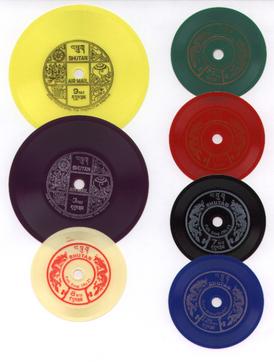
The first postage stamps of Bhutan were issued in 1962, the same year that the first motorable road was opened. Before that there was a mail delivery system in place for official mail using mail runners, and between 1955 and 1962 revenue stamps were accepted as payment for internal mail. With the opening up of Bhutan in the early 1960s, a formal postal system was introduced.
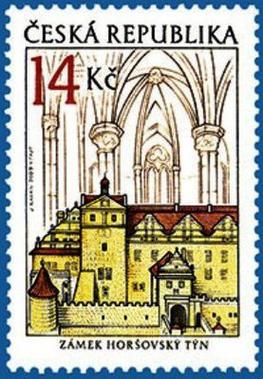
This is a survey of the postage stamps and postal history of the Czech Republic.

This is a survey of the postage stamps and postal history of Liechtenstein.
The Gibraltar-Vatican Joint Issue is a postage stamp that was released by Vatican City and the British Overseas Territory of Gibraltar in 2009. It commemorated the septcentenary of the devotion to Our Lady of Europe. The image on the stamp was a photograph of the statue of the Virgin and Child found in the Shrine of Our Lady of Europe at Europa Point in Gibraltar. The stamp was the first joint issue between Gibraltar and the Vatican.
John Barefoot is a British philatelist, stamp dealer, and publisher, best known for his catalogues of revenue stamps which are known collectively as the "Barefoot catalogue".
